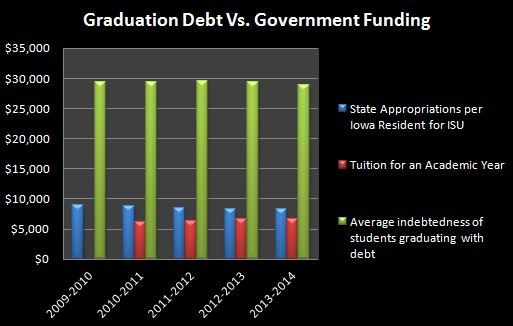Editorial: Government must find education important enough to fund
September 28, 2015
Students who graduate from Iowa public universities are, on average, heading off into the post-undergrad world with about $26,228 in debt, according to the latest Iowa Board of Regents Annual Financial Aid report.
ISU students graduating with debt have topped the rankings of those in Iowa with an average of $28,880, a number that’s decreased from $29,324 in 2012. This is compared with the University of Northern Iowa and University of Iowa, which sat around the $25,000 range.
Graduates from Iowa schools who graduate with debt are leaving with an amount that ranks in the top 10 in the nation.
But it just doesn’t make much sense.
Iowa State has one of the lowest tuition rates in its peer group that includes universities such as the University of Arizona, Michigan State, Ohio State, Purdue University-Main Campus, University of California Davis and Texas A&M. Base tuition for full-time resident undergraduates at these land-grant universities ranges from about $3,000 to more than $6,000 per semester. Iowa State is among the lower half at a base rate at $3,424 come spring 2016.
The amount of financial aid given to students across all Iowa regent universities has increased across federal, institutional and state sections, increasing from $715,843,549 in 2005 to more than $1 billion in 2013-14.
So why are students graduating from Iowa higher education institutes bogged down with more debt than those of other states?
Is it because increases in the Pell grant program, a federal need-based grant program based on income, have not kept pace with tuition increases? In 2002-03, the maximum Pell grant covered 98.0 percent of average public four-year tuition and fees, according to the regents 2015 annual financial aid report. In 2014-15, the grant covered only 63 percent. Iowa has the eighth highest gap between Pell grants and the total cost of education, according to the U.S. Department of Education.
Is it from a loss of funding for the Iowa Work Study program? This is a program that helps pay for student jobs on campus with federal, state and institutional funds. Work study pays for about 60 percent of the wages, while the place of employment takes care of about 40 percent.
Iowa State saw a decrease in Work Study funds of $35,394 between 2012-13 and 2013-14, according to the Regents document.
The maximum Pell grant award in 2013-14 was $5,645, according to the financial aid report, but the average national Pell grant award was $3,678. The average Pell grant award at Iowa regent universities was $3,754.
Is it because federal financial aid has decreased by about 4 percent during the last few years? If a 4 percent decrease doesn’t seem like too much, think about 4 percent of more than $500 million. That’s about $2 million.
While federal support has decreased, individual institutions and states have had to pick up the slack themselves. When state funding decreases at the same time tuition increases, students are forced to search for other methods to pay for college.
The approaching Wednesday deadline for the expiration of the Higher Education Act looms over legislative heads.
It’s simple, really.
If federal and state governments don’t find higher education important enough to sustainably fund, of course students are going to reach for loans to help pay for college. When the Iowa legislature underfunded Iowa’s regent universities last spring, the burden fell on the students
It’s time legislators take value in the state’s higher education programs. These students are a big portion of the state’s future. How do we expect they’ll contribute to the community and economy if they’re leaving with the most expensive piece of paper they’ll ever own?







